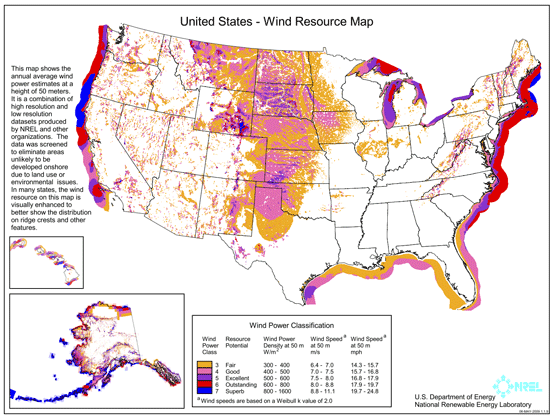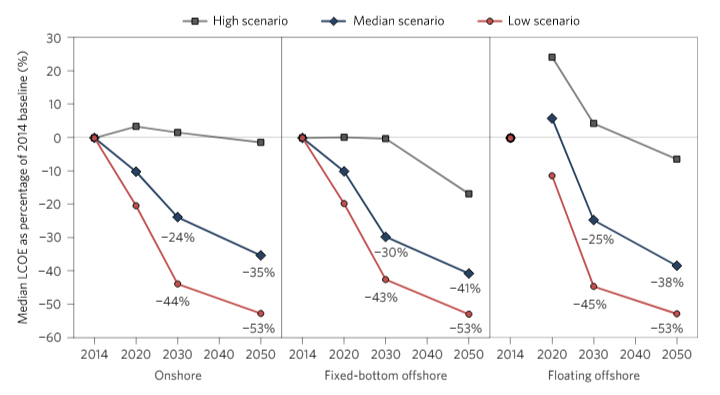As summer starts across the Northern Hemisphere, millions of families will flock to the beach for vacation. But the world’s coastlines are quickly becoming more than a tourist attraction; they’re increasingly home to one of the world’s most promising clean energy sources—offshore wind.
Offshore wind, in contrast to the widespread cost declines and capacity additions we’ve seen with onshore wind and solar PV, has historically been more of a ‘boutique’ resource—a great idea in theory, but still expensive and concentrated in certain parts of the world. That is now changing, as offshore wind becomes mainstream for three reasons: location, advancing technology, and declining price.
On location: Installing turbines offshore creates transmission costs, but these can be more than offset by the larger annual output—since the wind blows a lot more offshore than on—and by putting wind farms near major centers of electricity demand. Densely populated coastal cities require a great deal of energy, but that density makes transmitting power from remote wind and solar farms through high-voltage transmission a headache. At just 10-50 miles from the coast, offshore wind can directly provide power to congested areas, actually reducing transmission constraints and avoiding many of the siting conflicts that challenge onshore wind.
 The wind that blows offshore is much stronger and more consistent than what we get inland, making it a more reliable resource. The time at which this wind blows also correlates much more closely with the times of day we demand the most energy, particularly the late afternoon and early evening. This helps grid operators balance decreasing solar output as the sun sets, and can help grids wean off fossil-fueled resources they maintain to meet peak demand. In competitive markets, offshore wind developers can increase revenues by generating energy when power prices are at a peak.
The wind that blows offshore is much stronger and more consistent than what we get inland, making it a more reliable resource. The time at which this wind blows also correlates much more closely with the times of day we demand the most energy, particularly the late afternoon and early evening. This helps grid operators balance decreasing solar output as the sun sets, and can help grids wean off fossil-fueled resources they maintain to meet peak demand. In competitive markets, offshore wind developers can increase revenues by generating energy when power prices are at a peak.
Offshore wind’s proximity to coastal cities also creates serious economic potential for former industrial centers: In Maryland, offshore wind is expected to generate nearly 10,000 jobs and $1.8 billion in new in spending over 20 years. In Massachusetts it could revitalize up to 18 shuttered ports, and similar impacts are expected in New York and New Jersey.
On technology: Offshore wind turbines have doubled or tripled in size in a matter of years, with several companies manufacturing turbines nearly 10 megawatts (MW) in capacity with much higher power output. The 9.5-MW turbine from MHI Vestas, 187 meters in height, dwarfs the London Eye and can produce enough electricity to power more than 8,000 U.K. homes.
These larger turbines are key to reducing costs: Bigger turbines capture more of the wind’s potential for a variety of reasons, which increases their capacity factor. This means wind projects can generate more electricity with fewer turbines, and since nearly half of offshore wind’s costs going toward balance of systems (substructure, infrastructure, installation, etc.), getting more output from fewer turbines can save developers billions.
On price: At its cheapest, offshore wind energy is still more expensive than onshore wind and solar, but these technologies have had a decades-long head start: The first solar cells were being developed in the 1950s, and onshore wind farms date back to the 1940s, whereas offshore wind is only about a quarter-century old. But thanks to the technological advances described above, offshore wind is approaching an inflection point. Depending on the region and the project, offshore wind will be cost competitive sooner than many think.
In 2016 alone, average offshore wind costs dropped 22 percent. Bids for projects in Europe—home to more than 90 percent of installed offshore wind capacity—are now coming in below $60/MWh, down from the previously record-low cost of $111/MWh less than two years ago. In fact, Denmark’s Dong Energy and Germany’s EnBW recently won bids for offshore wind projects without any direct subsidies, though developers benefitted from pre-approved siting and interconnection. Similar results are expected in the United Kingdom’s upcoming national offshore wind auction. A study in Nature Energy estimates that offshore wind prices will continue to decline 30 percent by 2030 and 41 percent by 2050, and McKinsey is even more optimistic, forecasting a 68 percent price drop by 2020.

Nature Energy, 2016
With offshore wind approaching subsidy-free prices, oil companies are taking note, and making investments. Oil companies’ experience with managing larger, more capital-intensive projects, as well as their expertise in marine technology, positions them particularly well for the offshore wind industry. Shell maintains a 50 percent stake in a 680-MW Dutch offshore wind project, and envisions scaling projects to nearly 15 times their current size in order to reach cost-competitive scale.
Interest in offshore wind is continuing to expand abroad as well as here in America: Germany, Denmark, and Belgium have pledged to add 60 GW of offshore wind in the next decade (a fivefold increase from current installed capacity), and states across the Mid-Atlantic and New England have announced installation goals of more than 4,000 MW.
America’s first offshore wind farm off Rhode Island’s coast, while a relatively small-scale project of just 30 MW, will drastically improve air quality for 2,000 residents on nearby Block Island, who have been able to completely switch from diesel generation to zero-carbon electricity. If offshore wind can continue to scale, opportunities are limitless.
Hal Harvey’s Insights and Updates offers monthly thoughts and analysis on current energy and climate topics. These newsletters are written by Energy Innovation’s CEO Hal Harvey. Sign up here to receive Insights and Updates straight to your inbox.
